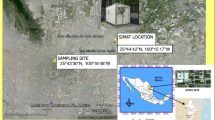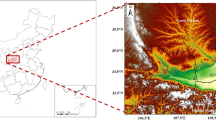Abstract
Atmospheric concentrations of BTEX were measured in an urban site located in the vicinity of an oil storage-distribution facility in Paraiso, Tabasco, Mexico. Samples were collected during two seasons (nortes 2018 and dry 2019). The relative abundance of BTEX mean concentrations was: toluene (5.24 µg m−3) > ethylbenzene (3.92 µg m−3) > m, p-xylene (3.89 µg m−3) > benzene (2.43 µg m−3). BTEX concentrations had a clear diurnal and seasonal pattern, showing higher levels during the dry season due to differences in wind conditions, rainfall patterns and temperature. Statistical analysis showed significant positive correlations among BTEX, indicating that these compounds had common sources. Interspecies ratios revealed that BTEX were originated from sources beyond vehicular traffic and that they were influenced by the transport of local air masses. The assessment of lifetime cancer risk showed that the population in the study area is at possible risk of developing cancer.



Similar content being viewed by others
References
Al-Khulaifi NM, Al-Mudhaf HF, Alenezi R, Abu-Shady ASI, Selim MI (2014) Seasonal and temporal variations in volatile organic compounds in indoor and outdoor Air in Al-Jahra City, Kuwait. J Env Prot 5:310–326
ATSDR (2005) Toxicological profile for benzene agency for toxic substances and disease registry (ATSDR). https://www.atsdr.cdc.gov/toxprofiles/tp3.pdf. Accessed 2 November 2020
ATSDR (2005) Toxicological profile for ethylbenzene agency for toxic substances and disease registry. https://www.atsdr.cdc.gov/ToxProfiles/tp110.pdf. Accessed 2 October 2019
Caselli M, Gennaro G, Marzocca A, Trizio L, Tutino L (2010) Assessment of the impact of the vehicular traffic on BTEX concentration in ring roads in urban areas of Bari (Italy). Chemosphere 81:306–311
Cerón Bretón JG, Cerón Bretón RM, Rangel Marrón M et al (2013) Diurnal variation of BTX levels in ambient air of one urban site located at the southwest of Mexico City during two seasons in 2013. Int J E Environ 6:261–271
European Union (2008) Air Quality Standards Directive 2008/50/EU. https://ec.europa.eu/environment/air/quality/standards.htm. Accessed 30 April 2021.
Gaur M, Singh R, Shukla A (2016) Variability in the levels of BTEX at a pollution hotspot in New Delhi, India. J Env Prot 7:1245–1258
INSHT (1992) Aromatic Hydrocarbons Determination in Air (Benzene, Toluene, Ethylbenzene, p-Xylene, 1,2,4-Trimethyl-Benzene) Adsorption in Activated Carbon/Gas Chromatography Method (INSHT Method: MTA/MA-030/A92). http://www.insht.es/InshtWeb/Contenidos/Documentacion/FichasTecnicas/MetodosAnalisis/Ficheros/MA/MA_032_A98.pdf. Accessed 4 May 2021
Kerchich Y, Kerbachi R (2012) Measurement of BTEX (benzene, toluene, ethylbenzene, and xylene) levels at urban and semirural areas of Algiers City using passive air samplers. A&WMA 62:1370–1379
Laowagul W, Garivait H, Limpaseni W et al (2008) Ambient air concentrations of benzene, toluene, ethylbenzene and xylene in Bangkok, Thailand during April-August in 2007. Asian J Atmos Env 2:14–25
Marciulaitiene E, Sereviciene V, Baltrenas P et al (2017) The characteristics of BTEX concentration in various types of environments in the Baltic Sea Region Lithuania. Env Sci P Res 24(4):4162–4173
Menchaca L, Mercado R, Mendoza A (2015) Diurnal and seasonal variation of volatile organic compounds in the atmosphere of Monterrey, Mexico. Atmos Res 6:1073–1081
Monod A, Sive BC, Avino P, Chen T et al (2001) Monoaromatic compounds in ambient air of various cities: A focus on correlations between the xylenes and ethylbenzene. Atmos Env 35:135–149
Ohura T, Amagai T, Fusaya M (2006) Regional assessment of ambient volatile organic compounds in an industrial harbor area, Shizuoka. Japan Atmos Env 40:238–248
Rad HD, Babaei AA, Goudarzi G, Angali KA et al (2014) Levels and sources of BTEX in ambient air of Ahvaz metropolitan city. Air Qual Atmos H 7:515–524
Sexton K, Linder SH, Marko D, Bethel H et al (2007) Comparative assessment of air pollution-related health risks in Houston. Env H Perspect 115:1388–1393
Tiwari V, Hanai Y, Masunaga S (2010) Ambient levels of volatile organic compounds in the vicinity of petrochemical industrial area of Yokohama, Japan. Air Qual Atmos H 3:65–75
US EPA (1994) Locating and estimating air emissions from sources of toluene United States Environmental Protection Agency Office of Air Quality Planning Standards Report EPA-454 ( R-93–047) Research Triangle Park, NC, 27711.
US EPA (1998) Indoor air quality: sick building syndrome United States Environmental Protection Agency Report EPA/402-F-94–004
Epa US (2009) A Minimal Risk Levels List United States Environmental Protection Agency Agency for Toxic Substances and Disease Registry Atlanta. GA, USA
US EPA (2013) Carcinogenic Effects of Benzene United States Environmental Protection Agency Integrated Risk Information System (IRIS). http://www.epa.gov/iris/subst/0276.htm. Accessed 20 September 2019
US EPA (1998) Carcinogenic Effects of Benzene: An Update United States Environmental Protection Agency Integrated Risk Information System (IRIS). http://www.epa.gov/iris/supdocs/0276index.html. Accessed 8 October 2019)
US EPA (2003) Toxicological Review of Xylenes United States Environmental Protection Agency Integrated Risk Information System (IRIS). https://cfpub.epa.gov/ncea/iris/iris_documents/documents/toxreviews/0270tr.pdf. Accessed 5 October 2019
US EPA (2005) Toxicological Review of Toluene United States Environmental Protection Agency Integrated Risk Information System (IRIS). https://cfpub.epa.gov/ncea/iris/iris_documents/documents/toxreviews/0118tr.pdf. Accessed 5 October 2019
US EPA (2008) Child–Specific Exposure Factors Handbook United States Environmental Protection Agency- National Center for Environmental Assessment. https://cfpub.epa.gov/ncea/risk/recordisplay.cfm?deid=199243. Accessed 5 October 2019
Zhang Z, Wang X, Zhang Y, Lü S et al (2015) Ambient air benzene at background sites in China’s most developed coastal regions: Exposure levels, source implications and health risks. Sci Total Env 511:792–800
Zheng H, Kong S, Xing X, Mao Y et al (2018) Monitoring of volatile organic compounds (VOCs) from an oil and gas station in northwest China for 1 year. Atmos Chem Phys 18:4567–4595
Author information
Authors and Affiliations
Corresponding author
Additional information
Publisher's Note
Springer Nature remains neutral with regard to jurisdictional claims in published maps and institutional affiliations.
Rights and permissions
About this article
Cite this article
Bretón, R.M.C., Bretón, J.G.C., Kahl, J.W.D. et al. Seasonal and Diurnal Variations of BTEX in Ambient Air from a Site Impacted by the Oil Industry in Southeast Mexico. Bull Environ Contam Toxicol 108, 212–218 (2022). https://doi.org/10.1007/s00128-021-03379-1
Received:
Accepted:
Published:
Issue Date:
DOI: https://doi.org/10.1007/s00128-021-03379-1




